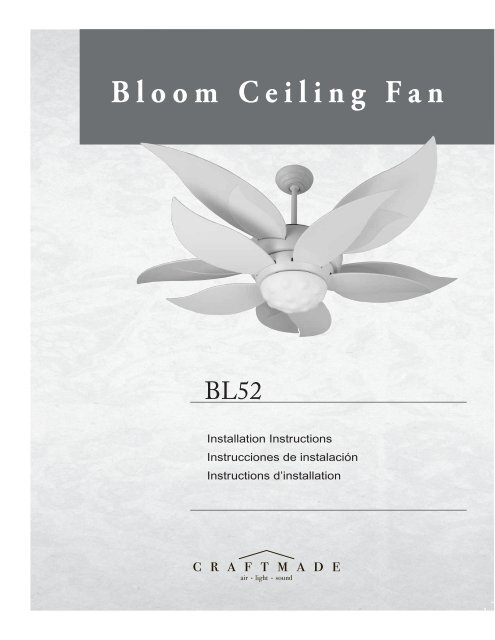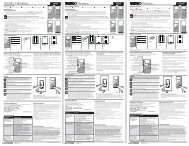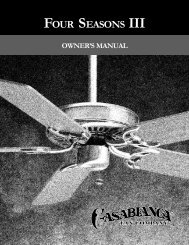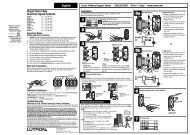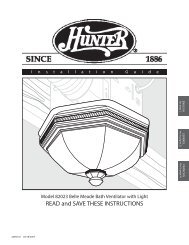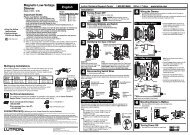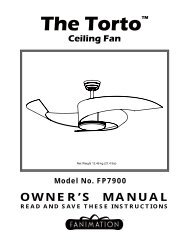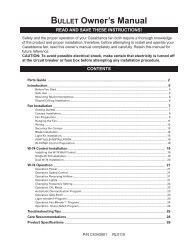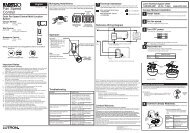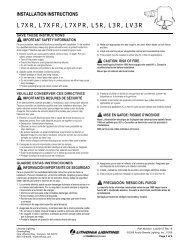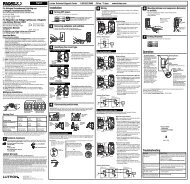Product Manual - Del Mar Fans and Lighting
Product Manual - Del Mar Fans and Lighting
Product Manual - Del Mar Fans and Lighting
You also want an ePaper? Increase the reach of your titles
YUMPU automatically turns print PDFs into web optimized ePapers that Google loves.
Bloom Ceiling Fan<br />
BL52<br />
Installation Instructions<br />
Instrucciones de instalación<br />
Instructions d’installation
1<br />
Read <strong>and</strong> Save These Safety Precautions<br />
1. Turn off electricity at main switch before wiring or servicing fan in order to avoid<br />
possible electrical shock.<br />
2. All wiring must be in accordance with the National Electric Code (ANSI/NFPA70-1999) <strong>and</strong> local<br />
electrical codes. Electrical installation should be performed by a qualified licensed electrician.<br />
3. After making the wire connections, the wires should be spread apart with the grounded<br />
conductor <strong>and</strong> the equipment-grounding conductor on the one side of the outlet box<br />
<strong>and</strong> the ungrounded conductor on the other side of the outlet box.<br />
4. The splices after being made should be turned upward <strong>and</strong> pushed carefully up into the outlet box.<br />
5. Conductor of a fan identified as grounded conductor to be connected to grounded conductor of power<br />
supply, conductor of a fan identified as ungrounded conductor to be connected to an ungrounded<br />
conductor of power supply, conductor of fan identified for equipment grounding to be connected<br />
to an equipment-grounding conductor.<br />
6. Fan should not be mounted in an area where it might get wet.<br />
7. To reduce the risk of fire, electric shock or personal injury, mount to outlet box marked<br />
"Acceptable for Fan Support" <strong>and</strong> use mounting screws provide with the outlet box.<br />
The outlet box <strong>and</strong> its support must be able to support the moving weight of the fan (at least 35lbs).<br />
8. For safety <strong>and</strong> best operating results, we recommend that you have a qualified<br />
electrician assemble <strong>and</strong> install your fan.<br />
9. WARNING: To reduce the risk of fire or electric shock, use the fan only with solid state speed control<br />
device provided.<br />
10. To reduce the risk of personal injury, do not bend the blade brackets when installing the brackets,<br />
balancing the blades or cleaning the fan. Do not insert foreign objects in between rotating fan blades.<br />
11. Net Weight: The weight of the complete fan, including assembly hardware is 30.64 lbs.<br />
Trouble Shooting<br />
Problem A: Fan Will not Start<br />
Remedies:<br />
1. Check fuse or circuit breaker <strong>and</strong> replace if necessary<br />
2. Turn off electrical power <strong>and</strong> check all wire connectors.<br />
3. Check on/off TCS <strong>and</strong> wall control selector switch. See operation instructions.<br />
Problem B: Fan is Excessively Noisy<br />
Remedies:<br />
1. Check that all screws in fan assembly are tight <strong>and</strong> properly seated.<br />
2. Check to make sure mounting bracket is installed properly.<br />
3. Check to make sure light kit <strong>and</strong> glass are installed properly <strong>and</strong> tight.<br />
4. If wall control is used, insure the wall control is not a transformer or a variable speed type.<br />
Problem C: Fan Wobbles<br />
Remedies:<br />
1. Check that all blades are screwed firmly into blade holders.<br />
2. Check that all blade holders are screwed firmly into motor.<br />
3. Check the weight of blades. All our blades are weighed on electronic scales. The weight is<br />
marked on the reverse side of the fan blade near the motor end. All of the blades should be<br />
the same weight to prevent fan from wobbling.<br />
4. A balancing kit is enclosed if needed.
2<br />
Before Assembly<br />
1. Make sure that the fan voltage (120) is compatible with your own electrical<br />
system.<br />
2. Check to make sure that your carton contains all the parts mentioned in the<br />
parts list.<br />
NOTE: The box can be used as a work space to prevent any damage on the<br />
ornamental surface.<br />
CAUTION: Before installing, choose a location for mounting the fan where the<br />
blades have at least 7 feet of clearance from all objects <strong>and</strong> floor. Mount an<br />
outlet box to the ceiling or use an existing box<br />
CAUTION: Do not mount fan to sheet rock or drywall type materials. To<br />
insure proper support, use the two #1 wood screws to secure mounting bracket<br />
to joist or beam. If the location you choose does not have a suitable support<br />
beam, install a 2”x 4” brace between ceiling joists to support.<br />
Screw Package<br />
S1. Wood Screws & Washers<br />
S2. Screws (for Canopy)<br />
S3. Bracket Screws & Washers<br />
S4. Blade Screws<br />
S5. Wire Connectors<br />
S6. Safety Bolt & Nut<br />
S7. "J" Hook<br />
S8. Zip Tie<br />
Quantity<br />
2<br />
3<br />
2<br />
3<br />
1<br />
1<br />
1<br />
Hardware<br />
Inventory<br />
S4<br />
S3<br />
S2<br />
S1<br />
S5<br />
S7<br />
S6<br />
Tools you Need<br />
1. Phillips Screwdriver<br />
3. Adjustable Wrench<br />
What You Have<br />
Parts<br />
1. Mounting Bracket<br />
2. Down Rod Assembly<br />
4" Rod Supplied<br />
3. Canopy<br />
4. Flange Cover<br />
5. Fan Housing & Motor<br />
6. Light Kit Glass<br />
7. Small Pedal Blades<br />
8. Large Pedal Blades<br />
9. TCS H<strong>and</strong> Held Control<br />
Quantity<br />
1<br />
1<br />
1<br />
1<br />
1<br />
1<br />
4<br />
4<br />
1<br />
1<br />
3<br />
5<br />
2<br />
4<br />
6<br />
2. Flat Screwdriver<br />
8<br />
7 9<br />
4.Wire Strippers
3<br />
Turn off circuit breakers <strong>and</strong> wall switch to the fan supply line leads.<br />
Preparation<br />
Important: When using an existing outlet box, be sure the box is<br />
securely attached to the building structure <strong>and</strong> can support the full<br />
weight of the fan. Failure to do so can result in serious injury or death.<br />
<br />
<br />
b.) Angle Mount<br />
<br />
IMPORTANT: If using the angle mount method, check to make sure the ceiling angle is<br />
not steeper than 35º. Angles greater than 35º will require a 45º angle adapter.<br />
30”<br />
84”
4<br />
Installing Mounting Bracket<br />
Support Beam<br />
Ceiling<br />
“J” Hook (S8)<br />
OUTLET BOX<br />
Outlet Box (A)<br />
Bracket Screws<br />
& Washers (S3)<br />
Mounting Bracket (1)<br />
Wood Screws (S1)<br />
Canopy Screws (S2)<br />
Wood Screws (S1)<br />
NOTE: Do not mount directly to sheet rock or ceiling tile.<br />
Prior to securing mounting bracket, screw "J" hook (S8) into ceiling outlet box<br />
as a secondary support means. Secure mounting bracket (#1) to the outlet box<br />
(A) by tightening bracket screws & washers (S3) as shown. If not mounting to<br />
an outlet box, use wood screws (S1) <strong>and</strong> washers (S3) <strong>and</strong> mount securely to<br />
ceiling beam. Be sure at this point to insert canopy screws (S2) in bracket.
5<br />
Unscrew <strong>and</strong> remove motor housing washer <strong>and</strong> motor housing top plate.<br />
Attach Large Pedal Blades from Top of Motor Housing.
6<br />
Reattach the Motor housing Plate <strong>and</strong> Motor Housing Washer as shown.<br />
Make sure the antenna wire is threaded through hole on top of motor housing.<br />
Downrod Assembly<br />
Locate downrod assembly (#2). Loosen ball screw on black hanging ball to<br />
free lock pin. Black hanging ball will slide down. Remove ground screw <strong>and</strong><br />
green ground wire. Remove hanging ball from downrod <strong>and</strong> save all parts.
7<br />
Insert fan wires through downrod.<br />
Thread the downrod onto the motor housing<br />
making sure the wires don’t get twisted.<br />
Insert safety bolt (S7) through flange & downrod<br />
<strong>and</strong> attach nut. Tighten firmly.<br />
Tighten set screw (A) against downrod.
8<br />
Place flange cover (4) over downrod assembly.<br />
Attach antenna wire to flange cover.<br />
Place canopy screw cover over downrod.<br />
Place canopy (3) over downrod (2).<br />
WARNING: Failure to completely tighten downrod as described in<br />
steps above could result in the fan loosening <strong>and</strong> possibly falling.<br />
Replace hanging ball, insert hanging pin through downrod <strong>and</strong> tighten set<br />
screw "C" in hanging ball into downrod.
9<br />
Lift fan onto the mounting bracket (#1). Turn housing until hanging ball seats<br />
itself into ball socket (listen for click).<br />
For added security, attach safety cable from fan unit to "J" hook (S8) in outlet<br />
box. Secure by looping zip tie (S9) through safety cable <strong>and</strong> "J" hook. Tighten<br />
zip tie securely.<br />
WARNING: To reduce the risk of fire, electric shock or personal injury,<br />
mount so outlet box marked "acceptable for fan support" <strong>and</strong> use mounting<br />
screws provided with the outlet box. Most outlet boxes commonly used for<br />
the support of lighting fixtures are not acceptable for fan support <strong>and</strong> may<br />
need to be replaced. Consult a qualified electrician if in doubt.
10<br />
Ground<br />
White (Neutral)<br />
Black<br />
(Power)<br />
White<br />
Black<br />
Blue<br />
Wire<br />
Connectors<br />
(S6)<br />
Ground<br />
(Green)<br />
Outlet Box<br />
Ground (Green)<br />
Downrod<br />
Ground<br />
(Green)<br />
Mounting Bracket<br />
Ground (Green)<br />
1. Connect fan wires to ceiling<br />
wires: white fan wire to white<br />
outlet wire, black to black <strong>and</strong><br />
green to green. Wire connectors<br />
(S6) are provided for your convenience.<br />
If an additional blue wire is<br />
present then also connect the blue<br />
wire to the black wire. (Optional<br />
light kit may be wired to individual<br />
wall switches, if desired.)<br />
2. After connections are made with<br />
wire connectors, turn splices<br />
upward <strong>and</strong> push carefully into<br />
outlet box. Separate blue <strong>and</strong> black<br />
wires on one side of the box, <strong>and</strong><br />
white <strong>and</strong> green wires on the other<br />
side.<br />
There are up to four wires coming from the<br />
top of the motor (including ground wire).
11<br />
Attach canopy (3) to the mounting bracket<br />
by placing screws (S2) into slot in canopy.<br />
Twist clockwise to lock into place.<br />
Tighten screws firmly.<br />
Seat the canopy screw cover into slots<br />
<strong>and</strong> twist to lock.
12<br />
Slide the small pedal blades into place, support <strong>and</strong><br />
attach with screws. (S4)<br />
Screw in c<strong>and</strong>elabra light bulbs. (not included)<br />
Place light kit glass over bulbs twist to<br />
lock into place.
Remote Control Operation Instructions<br />
ON/OFF<br />
HIGH<br />
MEDIUM<br />
LOW<br />
REVERSE<br />
FAN OFF<br />
For emergency shut off.<br />
Controls fan motor speed. To select desired speed, press<br />
button once <strong>and</strong> release.<br />
Controls direction of fan blades. To reverse fan blades, press<br />
once <strong>and</strong> release.<br />
Turns fan motor speed off. Press once to turn off. To start<br />
motor speed again, hit one of the motor speed buttons.<br />
L-1 Controls no function on this fan.<br />
L-2 Controls the on/off <strong>and</strong> intensity for optional light kit. Push<br />
<strong>and</strong> release for on/off function. Hold down for full range light<br />
dimming.<br />
NOTE:<br />
The “High”, “Medium” or “Low” buttons may be used to start<br />
the fan motor. The speed of the fan may be changed at anytime.


